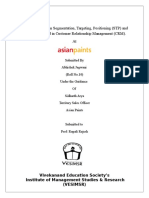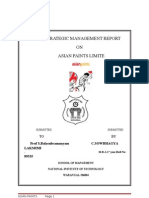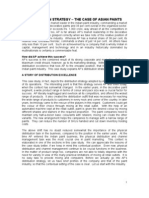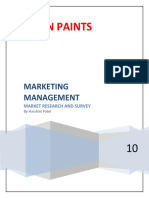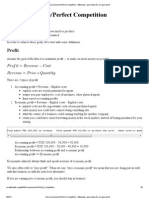Asian Paints Distribution Strategy
Uploaded by
Priyadarshi BhaskarAsian Paints Distribution Strategy
Uploaded by
Priyadarshi BhaskarAsian Paints Distribution Strategy
Page 1
INDEX
1. About Company
2. Product Mix
a. Decorative Segment
b. Industrial Segment
3. Paint Industry
4. Competitors
5. Retail and Service Initiatives
a. Color World
b. Color Idea.
c. Color store
d. Kids World
e. Asian Paints Helpline
6. Asian Paints (AP) Distribution Strategy
a. Prevailing Market Situation
b. Bypassing Bulk Buyers Segment
c. Entry to Semi-urban and Rural Markets
d. Going Directly To Retail Dealers
e. Open-Door Dealer policy
f. Nationwide Marketing/Distribution Reach
7. Implication Of Distribution Strategy
8. Distribution Strategy Implementation Process:
a. AP Created a Large Network of Dealers
b. AP Established a Network of Company Depots
c. AP Created a Marketing Organisation that Matched its Distribution Intensity:
d. Effective Cost-Service Distribution
e. Strong Commitment to Distribution Cost Control
f. Effective Inventory Management
g. Control Of Credit Outstanding
h. Information Technology Initiative:
i. Leadership Through Distribution Excellence
9. Conversion with Jamshedpur Dealer
10. References
Asian Paints Distribution Strategy
Page 2
1. About Company: Asian Paints is India's largest paint company and now Asias third-
largest paint company, behind Japans Kansai and Nippon, and the worlds 13th largest.
This year it appears on the Forbes Asia's Fab 50 for the third time in a row. It had
revenue of INR 10,970 crore in 2013 with 13.9% increase over previous year revenue.
Revenues from paint sales of the overseas operations of the group have increased by 23%
to INR 1,400.6 crores. It was founded in 1942 by four young men Champaklal H.
Choksey, Chimanlal N. Choksi, Suryakant C. Dani and Arvind R. Vakil. in a garage in
Bombay. The name Asian Paints was picked randomly from the telephone directory.
From 1968, this brand occupies a premium position in the Indian Paint industry. Asian
Paints operates in 21 countries with 29 paint mfg. facilities with capacity of 440
mn.Lts/annum, servicing consumers in 65 countries. Asian Paints operates in five regions
across the world viz. South Asia, Southeast Asia, South Pacific, Middle East and
Caribbean region through the five corporate brands viz. Asian Paints, Berger
International, SCIB Paints, Apco Coatings and Taubmans. It is ranked among the top 10
decorative coatings companies in the world. It is a fully-integrated paints company.
Figure 1: Geographic wise sales contribution
2. Product Mix: Asian Paints manufactures and markets industrial and decorative coatings.
Along with that the company also provides home painting services and solutions. The
company's key products and brands include the following:
Asian Paints Distribution Strategy
Page 3
Figure 2: Product Mix
a. Decorative Segment:
Wall Finishes: Powerful brands like Tractor, Royale, Royale Play, Apcolite etc.
Enamels Brands viz. Apcolite Synthetic Enamel, Utsav Enamel dominate
Exterior Finishes: Brands like Apex, Apex Ultima, Ace dominate segment in just
a few.
Wood Finishes: Powerful brands viz. Touchwood, Asian Melamine Wood Finish
b. Industrial Segment:
General Industrial Finishes: Apcolite (Hammerton Finish)
Other Industrial Products: Expory Coatings, Chlorinted Rubberfinishes, viny I &
Polyurethane Systems.
3. Paint Industry: Over the past few years, the Indian paint market has substantially grown
and caught the attention of many international players. The growth in the market is
driven by emergence of the middle class in India, growing infrastructure, increase in the
tendency to spend and growing young population inclined towards lavish lifestyle. On
the back of such advocacy, it is anticipated that the sector will post a CAGR of around
16.2% during 2013-14 to 2015-16. Companies with attractive marketing strategies and
comprehensive product portfolios are expected to gain greater market share.
Additionally, the increased focus on research and development of the paints will lead to
Asian Paints Distribution Strategy
Page 4
greater advancements. Annual paint consumption is 1.9 kilos a person, as opposed to 5.5
kilos for the Asia-Pacific region.
Consumption in rural areas is growing even faster, and thats where the company has
long been the strongestAsian Paints wooed small shopkeepers in villages and tiny
towns early on because foreign companies dominated paint sales in the cities. All the
major players in the $5.3 billion Indian paint market are expanding capacity and seeking
to boost market share. Decorative paints available in wide range of combination account
for 70% of the coatings total production. While industrial paints share the balance of
30%.This rate is diametrically opposite to the trend in the industrialized countries where
industrial paints account for 70% and Decorative paints for the balance of 30%.
4. Competitors:
a. Kansai Nerolac Paints: It is largest in industrial paint and second largest decorative
paint company based in Mumbai. It is a subsidiary of Kansai Nerolac paints, JAPAN.
It is engaged in the industrial, automotive and powder coating business. It is the
subsidiary of Kansai Paints Ltd Japan.
b. Berger Paints India: It has come a long way since its inception in the year 1923.
Indias second largest decorative paint player, Berger Paints is headquartered in
Kolkata and services the market through a distribution network of 82 stock points and
12,000+ paint retailers.
c. Akzo Nobel India: It is the fourth largest player in the domestic paint industry in
terms of revenues, and known for its premium segment product Dulux, is targeting to
emerge the No.2 in the next five years. Akzo has a market share of 9-10. It is the
Indian arm of the Amsterdam-headquartered global paints and coatings leader, Akzo
Nobel.
Figure 3:Market share
Asian Paints Distribution Strategy
Page 5
5. Retail And Service Initiatives:
a) Colour World: Customers are the very core of all business activities. From the
beginning, Asian Paints has fostered a customer-centric approach to business. A
simple but unbeatable concept of "going where the customer is" drives all the retail
strategies. In the early 90s, for the first time in the paint industry Asian Paints offered
the consumer over 150 shades. The concept was extended to the dealer shops through
Colour World in the mid-90s, where Asian Paints began offering over 1000 shades.
The introduction of Colour World provided a new direction for the paint industry into
the age of retailing by providing the consumer - a service interface. With only a
limited set of bases and colourants, manufactured and transported throughout the
supply chain, Asian Paints provided a choice of innumerable shades to the customer
through a technology of tinting at the last retail store. With the introduction of Colour
World, almost all wall-finishes from Asian Paints offer a wide range and choice in
colours be it for interior or exterior application. It has been our endeavour to reach out
to the customers not only with their products but also with value-added services and
initiatives.
b) Colour Idea: Stores too have gone upmarket. In 2009 the company introduced
dealer-owned Colour Idea stores and now has 100 of them. Unlike traditional dealers
who sell through hardware stores, the new stores focus on matching customers to the
right colour. Theyre outfitted with boards displaying samples of interior and exterior
finishes, and theres a consultant who provides computer visuals showing how a room
will look when painted.
Figure 4: View of Colour Ideas store
Asian Paints Distribution Strategy
Page 6
c) The Colour Store: Asian Paints also runs two high-end showcase stores, in Mumbai
and New Delhi. These dont sell any paint, but have walls of displays showing various
shades and textures under different light settings. It is a retail experience that offers a
personalized colour solution to each customer without directly selling a single can of
paint (the paint itself is sold via a network of nearby dealer stores).Style preferences,
colour ideas, and other details are stored on RFID color cards as consumers move
through the store. At the end of the experience, they download their card and watch as
a customized colour magazine is created. They can then take their magazine to any
Asian Paints dealer store to choose and purchase paint, or they can use the magazine
as a discussion tool with their architect or designer.
Company continued to broaden its network by installing more than 2900 Colour
Worlds, taking the tally of Colour World dealers to over 24000 across the country. At
the top of retailing hierarchy, Company increased Colour Ideas Stores to almost 100.
Hassle-free painting solutions offered through the Asian Paints Home Solutions
(APHS) service was used across 13 cities. The service experience was enhanced by
introducing mechanisation in painting. Customer satisfaction scores and customer
feedback continue to guide the APHS operations. Colour Next (annual colour trend
forecast) has become a strong brand amongst Architects and Interior Decorators
(AIDs).
d) Kids World: Another important area was the offer of painting solutions for children
with the launch of Kids World. A foray into Kids' World marks yet another milestone
wherein the company offers painting designs for Kids Rooms as well as Kids Corners.
For the first time, an attempt has been made to invite the customer to get into a Do-It-
Yourself mode with these designs.
Figure 5: View of Kids Store
Asian Paints Distribution Strategy
Page 7
e) Asian Paints Helpline: In the late 1990s it started a customer helpline, which now
gets 2,000 calls a month. It offers home-painting services in 13 citiesan employee
comes to a home, sizes up the job, brings in painters who cover up the furniture and
do the work. It sent out Happy Painting Guides to 300,000 customers last year. It
provides colour consultancies, in which an employee with interior-design training
comes to the home to suggest what can be done for the walls.
f) It trains 8,000 painters a year in two-day workshops to ensure they apply its premium
paint in the right way. Customer interaction leads to insights: It has started offering
200 ml samples of its premium paint at a nominal price, allowing a customer to paint
a swath of a wall to see how the colour will looka significant improvement over the
shade card.Asian Paints efforts are continuously on to engage the consumer in the
painting process and fulfill all the requirements related to the world of painting.
g) It introduced computerised colour-matching in the mid-1970s. There were PCs in
branches by the early 1980s. Today it dishes out a free paint app for smart phones. A
key factor in Asian Paints coming out ahead of the competition is the significantly
better supply chain it had, which allowed the company to service a much larger
number of dealers than the competition.
6. Asian Paints (AP) Distribution Strategy:
a) Prevailing Market Situation: Previously, for Indian paint business, distribution
was the most crucial task for any new entrant. Both physical distribution and channel
management posed formidable challenges. The foreign companies and their
wholesale distributors dominated the business. The foreign companies appointed a
few traders as their wholesale distributors and allowed them to perpetuate a situation
of monopoly. Each distributor was assigned a large territory and was given the right
to operate as the exclusive channel of the company in the assigned territory. The
trade terms were also very liberal. The companies also extended virtually unlimited
credit to the distributors. The credit out-standings for the supplies made throughout
the year were required to be settled by the wholesale distributors only at the year-
end, at Diwali time. These distributors had neither the compulsion nor the
motivation to invest in distribution infrastructure. They were not required to move
out to semi-urban and rural areas. They concentrated on big cities where they could
make the sales without much investment in distribution infrastructure and market
development. Also, they were shutting the doors on any new paint company seeking
an entry into the business. In other words, these distributors controlled the paint
business and were making it impossible for a new paint company to enter and
establish itself in the business. Asian Paints sized up the scenario correctly and
formulated a unique distribution strategy. In the normal course, a firm entering the
industry in this scenario would have opted for the low risk strategy of gaining a
limited access to the wholesale traders and be satisfied with a small share of the
Asian Paints Distribution Strategy
Page 8
existing business. But Asian Paints went in for a strategy that differed totally from
the existing pattern. Its strategy in fact, meant the polar opposite of the
established/existing pattern.
b) Bypassing Bulk Buyers Segment: Bulk buyer segment was the major segment of
the paint business in the earlier days and any paint company needed a share of this
major segment for sheer survival. Though, this segment was dominated totally by
foreign companies and their wholesale distributors, a company like AP would
normally have rushed to this segment and tried to garner a share of it. AP, however,
had a totally different game plan. Seeing that this segment was not a growth
segment, though it was certainly the major segment at that point of time, AP decided
to ignore this segment for the present and go to individual consumers. And that was
a crucial decision. It influenced every subsequent decision AP took in the realm of
distribution. Over time, AP proved to the paint industry that there existed a large and
bottomless segment in the paint business of India, outside the bulk buyer segment,
comprising of individual consumers.
c) Entry to Semi-urban and Rural Markets: Along with the decision to go to
individual consumer segment leaving aside the bulk buyer segment, AP also decided
that within the individual consumer segment, semi-urban and rural areas would
constitute APs priority market. All the major paint companies and their wholesale
distributors were content with the market that was available in the urban areas. In
contrast, AP clearly saw that a large market for paints was emerging in the semi-
urban and rural areas, and felt it wise to tap this market. AP also understood that a
company like AP had also a compulsion to go to the semi-urban and rural areas. The
major companies and their wholesale distributors were not giving any worthwhile
opening in the big cities for new entrants. AP found it difficult to attract the
wholesalers in the cities to deal in its products. It had to necessarily turn to the semi-
urban and rural areas for support. AP wisely decided against committing all its
resources on a head on collision with the foreign companies and their big wholesale
distributors in the urban areas.
d) Going Directly To Retail Dealers: It was the next major strategic decision of AP in
the realm of marketing and distribution. Here too, AP totally broke with the
prevailing distribution practice. It totally bypassed the well-entrenched wholesale
distributors and went directly to the retailers. While APs competitors remained
content with their linkage with a handful of wholesale distributors, AP preferred
direct contact with hundreds of retail dealers.
e) Open-Door Dealer policy: AP followed the policy in the matter of adding retail
dealers to its network. The prevailing trend in those days was to limit the number of
dealers to the barest minimum. AP broke this trend and chose to use practically
everyone in the trade, who was willing to function as its dealer. It was as a combined
Asian Paints Distribution Strategy
Page 9
result of the policy of going directly to retailers and the policy of open door to
dealership that APs dealer network swelled rapidly. Even after achieving stability
and maturity in distribution, AP continued to follow a policy of continuous
expansion of dealer network. By 1990, AP was having a 7,000 strong dealers
network. By the year 2000, the number had swelled to 12,000. And even now, on an
average, AP is adding 200 to 250 new dealers every year and now in 2014, the
number reached to 35,000.
f) Nationwide Marketing/Distribution Reach: AP took yet another important and
strategic decision in the realm of distribution. Those days nationwide
distribution/marketing was not the standard practice in the paint business. On the
one side, there were the 1,000 odd small paint companies who, as a class, believed in
marketing their paints in limited territories in and around their point of production.
On the other side were the big companies, who as a class, believed in limiting their
distribution to the big cities. In contrast to both these existing practices. AP voted for
a nationwide distribution/marketing. It wanted to have an active presence throughout
the country, in all the geographical zones, states and territories.
7. Implication Of Distribution Strategy: APs distribution strategy described in the
preceding paragraphs had its associated implications. AP had taken due note of them and
faced them squarely.
a) Had AP concentrated on the bulk buyer segment, it could have managed with a
limited product range, at least, in the initial years. But, APs decision to turn to the
individual consumers necessarily meant a wide product range. In the nature of things,
the individual consumer segment involves a very wide choice in terms of products,
materials, shades and pack sizes. On top of this, AP believed in making products
based on the preferences of consumers. It gathered feedback from the consumers and
turned out products, shades and pack sizes on the basis of such feedback. This policy
resulted in a further burgeoning of the product range.
b) At the time of APs entry, paint companies were supplying paints in containers of 500
ml or larger. AP saw that there was a felt need in the market for paints in smaller
packs. All end uses did not require a large quantity. Moreover, it was common
practice for consumers to buy paint initially in a larger quantity and supplement it
with small size purchase to complete the job. AP decided to harness the business
opportunity and started supplying it paints in small packs- in 200 ml, 100 ml and 50
ml packs. This proliferation in pack sizes also contributed to APs growing product
range. AP was by now manufacturing and marketing as many as 2,000 distinct items
of paints, none of which was strictly a substitute for the other.
c) The policy of having the widest range of products, colours and pack sizes had it
implications on APs distribution. When 2,500 different items had to be made
Asian Paints Distribution Strategy
Page 10
available to the consumers, it automatically meant that the company had to be
prepared for high inventory holding in its various depots/retail outlets. Accounting
and sales arrangements had also to be provided for on a matching level. Naturally,
distribution was becoming more complex and expensive for AP.
d) The decision to go to the semi-urban and rural markets instead of confining to the
urban markets also meant enlargement of the distribution function. AP had to go in
for more dealers in order to serve the scattered semi-urban and rural market. The
decision also meant that AP could not opt for a simple, centralised distribution of its
products from its factory. It had to go in for a decentralised, field-focussed
distribution, with a network of depots located all over the country/marketing territory.
Without such extensive and intensive distribution network, it would not have been
possible for AP to cover the semi-urban and rural markets.
e) Through its decision to go retail, AP was getting deeply involved in physical
distribution and channel management. In the system chosen by AP, the physical
distribution-cum-channel management task was far more demanding, compared to the
wholesaler-oriented system practised by the other paint companies. While, for
companies that embraced the wholesaler-oriented system, it was enough to service a
handful of distributors, AP had to service a network of thousands of retail dealers.
Having taken the decision to go retail, AP necessarily had to create and service a vast
dealer network. It also had to create the physical distribution facilities required for
servicing such a large network.
f) Extent of marketing territory and complexity of distribution organisation are
interrelated. The moment AP voted for nationwide marketing, it was getting into
intensive as well as extensive physical distribution and channel management. AP thus
had to create a nationwide distribution-cum-marketing organisation.
g) APs strategies made distribution the most important element of its marketing mix. And,
AP gave to distribution all the inputs that were demanded by it.
8. Distribution Strategy Implementation Process:
a) AP Created a Large Network of Dealers: An extensive network of dealers and a
matching physical distribution infrastructure play a crucial role in the decorative
paints segment. This is essential for ensuring easy accessibility of the product to
customers. In this, Asian Paints scored over its competitors with a massive network of
35,000 dealers spread over 3,500 towns across the country. AP has the largest
distribution network among all the players.
b) AP Established a Network of Company Depots: AP established a large chain of
company operated depots/stock points throughout its vast marketing territory, from
Asian Paints Distribution Strategy
Page 11
where the retail dealers could conveniently pick up their requirements. APs basic
strategies explained in the earlier sections necessitated a liberal approach in the matter
of stock points/depots. It also meant that the depots had to be company operated.
After all, AP did not have any wholesale distributors to whom the responsibility for
operating the stock points could possibly have been assigned. AP established a
network of 72 company-run depots, spread throughout the country and serviced its
retailers from them. The number of depots varied from city to city. For example,
Bangalore had just one depot while Mumbai had four depots. The depot typically
supplied to about 200-300 dealers.
c) AP Created a Marketing Organisation that Matched its Distribution Intensity:
Effective control of the large number of depots, each having substantial stocks of
2,500 odd distinct items necessitated a matching marketing organisation structure. AP
set up a marketing organisation consisting of 6 regional sales offices, 150 branch
sales offices and a 500-person strong sales force e.g. sales supervisors and sales
representatives spread all over the country. The marketing organisation of the
company is presented in figure 6. It can be seen from the chart that a very extensive
structure has been created in the consumer division. It is primarily meant for taking
care of the massive distribution task involved in this sector. Each branch sales office
has its own depots and the various items are stocked in the depots under the control of
the concerned branches. The branches service the dealers and customers in their
territories. These are supported by 6 regional distribution centers, which cater to 72
depots. Each depot has a branch manager for supervision of several salespersons who
cater to more than 30,000 dealers in the more than 3,500 big and small cities all over
the country.
Asian Paints Distribution Strategy
Page 12
Figure 6: Marketing Organization Chart
d) Effective Cost-Service Distribution: Managing the cost-service conflict was the
main challenge that AP faced in the implementation of its distribution strategy. AP
caters to all of them directly. As a result, for AP, the distribution task gets
tremendously extended and distribution cost becomes a significant business
parameter. Demand for decorative paints is characterised by seasonality. Demand
drops during monsoons and picks up around a mouth-and-a-half before the festive
season. Major part of the sales takes place in the second half of the financial year.
Manufacturers have to carry huge inventories during the lean period. As a result,
distribution cost becomes all the more significant. Naturally, distribution cost
emerged as a major hurdle that AP had to cross. The strategy adopted by AP
necessitated expensive distribution. In addition, AP took another basis decision. It
went in for a very high service level in distribution. Service level is measured in terms
of the number of stock keeping units (SKUs) available in stock as a percentage of the
number of SKUs that should have been in stock. A high service level in physical
distribution-in transportation, warehousing, order processing and inventories
necessarily means a high level of costs. Every firm has to face this cost-service
dilemma and work out a compromise. AP voted for a high service level and without
compromising this service level, it tried to contain the distribution costs. Interestingly,
AP succeeded in this endeavour.
General Manager
Marketing
Sales Manager
Trade
Manager
Export
Sales Manager
Industrial
Product
Managers
Product
Executives
Sales
Supervisor
Branch Managers/
Depot Executives
Zonal
Managers
Regional Sales
Manager
Product
Managers
Sales
Representative
Sales
Representative
s
Service
Representative
s
Product
Executives
Asian Paints Distribution Strategy
Page 13
e) Strong Commitment to Distribution Cost Control: While following a totally
customer-oriented distribution strategy. AP could not afford to ignore the cost angle.
AP was in no position to pass on any additional costs to the consumers. APs
marketing philosophy demanded that the consumer price of its paints should be on the
lower side, so as to suit the pockets of the average Indian. Moreover, APs business
growth demanded more and more investment in manufacturing and distribution. AP
had to find the resources. This apart, the intensity of competition had also been on the
increase. Naturally, profitability was coming under greater strain in these
circumstances. AP had to control its distribution costs in order to maintain its
profitability and market leadership.
f) Effective Inventory Management: Effective inventory management is the first
major component of APs strategy on distribution cost control. And, AP achieved
high efficiency in this regard. Actually, in inventory cost, AP took the lowest position
in the industry. APs average inventory level significantly lower than industry
average. This right away edge in inventory costs to AP compared t its competitors.
APs stock of finished goods was just 7 per cent of its net sales while for the others in
the industry it was nearly twice that level. What is particularly striking in this
achievement is that AP offered customers and dealers a high level of service in
product delivery compared to its competitors and yet kept the inventory costs down
by 45 percent compared to the competitors.
g) Control Of Credit Outstanding: Large credit out standings, running beyond two
months or more, was a natural concomitant of the distribution strategy chosen by AP.
The dealers are required to maintain stocks of all the SKUs that are on demand in the
territory. It pushes up inventory levels at the outlets. They need credit. AP allowed
15-21 days credit for dealers located in the major towns and 22-30 days credit for
dealers in upcountry regions. AP had to pull off a smart credit control strategy for
survival. It resolved the thorny problem through an innovative dealer incentive
scheme. AP stipulated that each of its dealers should pay for the supplies within a
specified time norm and offered them as attractive incentive scheme for doing so. It
consisted of two components:
A special discount of 3.5 per cent. This was referred to as the discount for
perfection in payments. It was passed on at the end of the year, provided each
and every payment throughout the year was made within the stipulated time
norms.
A cash discount of 5 per cent. This was paid for all outright cash purchases. It
was given whenever payments were received within 24 hours of the
supply/invoice. In respect of outstation accounts, the payment has been made in
advance by draft in order to be eligible for the cash discount.
Asian Paints Distribution Strategy
Page 14
The scheme was a grand success. APs credit out standings always stood below 25
days, better than the other major companies. Systematic computerisation also helped
AP maintain the credit outstanding within limits.
h) Information Technology Initiative: Information technology (IT) plays a key role in
enabling the company to grow and generate profits. Asian Paints is the only company
in India to have integrated Supply Chain Management (SCM) Solution from i2
Technologies, and Enterprise Resource Planning (ERP) solution from SAP. With
these IT tools firmly in place and with the backing of an extensive communication
platform, it is an internally enabled enterprise. It has integrated all its stakeholders
including suppliers, employees and customers and created an extended enterprise.
Asian Paints has launched a supplier portal that includes an automated digital
document exchange facility that has improved the efficiency and effectiveness of
interaction with suppliers. An employee portal has also been set up. Customer
Relations Management (CRM) tools are being used in Asian Paints Helpline and
Home Solutions initiatives. The successful deployment of ERP, CRM, Business
Intelligence and Portal software from leading solution providers and integrated SCM
systems has helped in improving efficiency in the business as well as increase the
transparency and accuracy of information across the company. In order to affect 24x7
availability of their IT infrastructure, they have set up a disaster recovery site in South
India. To match the pace of growth of their international business, it is focusing on
improving transaction systems and messaging platforms. The decision-making
capability has been raised within the organisation to next level by investing in cutting
edge In-Memory Database technology from SAP called HANA. This has provided the
managers with powerful and faster analysis capabilities.
The IT initiatives also ensured prompt billing, accurate customer accounting and
effective control of credit outstanding. Computerisation also enabled AP to process
recent sales data for the 100 fastest moving SKUs. This analysis was used to project
sales of specific products, which helped plan production and raw material purchases.
With computerisation, AP was able to analyse past trends to arrive at a 90 per cent
accurate sales forecast. Corrections were made every month between the sales
projections and actual sales. Production was thus evened out month-to-month. Sales
statistics were maintained, classified by product, month, salesman, branch, region and
dealer. Such computerised planning and control of production, sales and inventories
helped AP cut distribution costs without compromising on the high level of service
sought by it in physical distribution.
i) Leadership Through Distribution Excellence: The story of Asian Paints is a story
of distribution excellence. AP achieved an enviable leadership position through the
distribution route. While AP did not ignore any of the other functions of marketing, it
was by mastering the distribution function that APs gained a distinct and powerful
competitive advantage. APs distribution strategy was truly innovative; it broke new
Asian Paints Distribution Strategy
Page 15
ground in every aspect of distribution. In the final analysis, excellence in distribution
led the company to marketing and corporate excellence
9. Conversation With Jamshedpur Asian Paints Dealer: We visited the dealer named
Ashoka Enterprise at Bistupur. Following are the findings that dealer informed us about:
Dealer deals with Asian Paints and Akzo Nobel.
Turnover of the dealer was 9.5 Cr and out of which 7 is from Akzo Nobel
Dealer is also working as a whole sale dealer for smaller dealers in rural area.
Acqua is the name of agency (based at Ranchi) that delivers all the paint products to
the dealers across Jamshedpur
Credit terms- Asian Paints- 7 days, Dulux- 21 days
Company has made many dealers in Jamshedpur area and therefore the power of the
dealers is diluted.
Items are ordered as per the requirement of shopkeepers only
Its tough to understand the Promotional schemes of Asian Paint and most of the
consumer schemes stock and promotional items remains out of sync.
Shopkeepers show different paint shades to the customers, customers also come
prepared after doing online search on the companys websites for the right kind of
shade.
Margin average around 7% which is lower than Azko Nobels.
Customized paints are prepared on customer demand at the shop.
Supply is very good.
Dealer has significant clout and therefore do not accept tagging/dumping terms and
therefore excluded from Critical retail services (CRS) system. The entire newly
launched / premium product schemes first given to CRS dealer and then given to other
dealer with a time lag.
Brand pull is good.
Claims settlement takes long time and sometimes it drags to even more than one year.
Company asks for feedback, but hardly implements i.e. Dealer has suggested
packaging improvement in Asian Paints Apcolite but Asian Paints did not change
and hence lying uselessly in the shop.
Painter training is done by the company itself.
Incentive schemes to painters were first given through dealers, but now those are
directly given to the respective person e.g. to the Painters and dealer has no say.
Targets are given to the dealer, but once the target met, prizes are given to the local
performers
Area sales manager hardly visits the dealers shop
Return of slow moving goods also depend upon the clout of the dealer.
All the points discussed above in the report regarding AP distribution strategy were
found consistent.
10. References:
Asian Paints Distribution Strategy
Page 16
Asian Paints annual report.
http://www.scribd.com/doc/6655788/ASIAN-Paints-Distrbn
You might also like
- Project Report On Marketing of Industrial Paint 1100% (3)Project Report On Marketing of Industrial Paint 155 pages
- Paint Industry: Industry Origin and Growth100% (2)Paint Industry: Industry Origin and Growth50 pages
- Frequently Asked Questions: Q. What Are The Common Exit Formalities After Resignation?100% (1)Frequently Asked Questions: Q. What Are The Common Exit Formalities After Resignation?12 pages
- Sales Promotion & Advertisement Practices at Asian Paints LTD75% (12)Sales Promotion & Advertisement Practices at Asian Paints LTD68 pages
- A Study of Dealers Behaviour On Marketing of Paints100% (2)A Study of Dealers Behaviour On Marketing of Paints69 pages
- "Brand Comparison of ITC's PCP Range With Current Market Leaders and Suggesting Promotional Strategies For Brand PositioningNo ratings yet"Brand Comparison of ITC's PCP Range With Current Market Leaders and Suggesting Promotional Strategies For Brand Positioning60 pages
- Sales and Distribution Management of Asian PaintsNo ratings yetSales and Distribution Management of Asian Paints21 pages
- Project On Marketing Strategy of Asian Paints100% (7)Project On Marketing Strategy of Asian Paints52 pages
- Asian Paints - Marketing Management Report100% (2)Asian Paints - Marketing Management Report24 pages
- Distribution and Channel Management: Berger Paints India Ltd. (BPIL)No ratings yetDistribution and Channel Management: Berger Paints India Ltd. (BPIL)19 pages
- Consumer and Dealer Behaviour Towards Berger PaintsNo ratings yetConsumer and Dealer Behaviour Towards Berger Paints9 pages
- South Asia Southeast Asia South Pacific Middle EastNo ratings yetSouth Asia Southeast Asia South Pacific Middle East3 pages
- Kenya Freight Clearance and Forwarding Proceedures - Aeromarine Capital - Freight Clearing Forwarding KenyaNo ratings yetKenya Freight Clearance and Forwarding Proceedures - Aeromarine Capital - Freight Clearing Forwarding Kenya7 pages
- India Ranks 46th in WB Logistics Index: Service TaxNo ratings yetIndia Ranks 46th in WB Logistics Index: Service Tax1 page
- Examples of A 30 or 60-Second Elevator Pitch - ImprovAndy100% (1)Examples of A 30 or 60-Second Elevator Pitch - ImprovAndy11 pages
- Cambrdige - Cost, Demand, and Willingness To Pay EstimatesNo ratings yetCambrdige - Cost, Demand, and Willingness To Pay Estimates2 pages
- Đề Cương Giữa Kỳ i Tiếng Anh 12 Văn LangNo ratings yetĐề Cương Giữa Kỳ i Tiếng Anh 12 Văn Lang21 pages
- General Works Method Statement - SAKURA PDFNo ratings yetGeneral Works Method Statement - SAKURA PDF4 pages
- Systems Analysis and Design and How It Works For BusinessNo ratings yetSystems Analysis and Design and How It Works For Business3 pages
- Air Ticket Booking - Book Flight Tickets - Cheap Air Fare - LTC Fare - IRCTC AIR0% (1)Air Ticket Booking - Book Flight Tickets - Cheap Air Fare - LTC Fare - IRCTC AIR1 page
- David N. Lorenzen - Bhakti Religion in North India - Community Identity and Political Action-SUNY Press (1994)No ratings yetDavid N. Lorenzen - Bhakti Religion in North India - Community Identity and Political Action-SUNY Press (1994)29 pages
- Project Work 2.1 Project Guide 3. Project Work - Phases 3.1 Phase I: Project Synopsis and Guide ApprovalNo ratings yetProject Work 2.1 Project Guide 3. Project Work - Phases 3.1 Phase I: Project Synopsis and Guide Approval6 pages
- Hartono Silalahi C/O. Perum. Nusa Batam Block I No. 38 Batuajibatam Mobile: + 62 81372125428No ratings yetHartono Silalahi C/O. Perum. Nusa Batam Block I No. 38 Batuajibatam Mobile: + 62 8137212542826 pages
- Present Simple Reading Comprehension A2 Printable WorksheetNo ratings yetPresent Simple Reading Comprehension A2 Printable Worksheet2 pages
- Frequently Asked Questions: Q. What Are The Common Exit Formalities After Resignation?Frequently Asked Questions: Q. What Are The Common Exit Formalities After Resignation?
- Sales Promotion & Advertisement Practices at Asian Paints LTDSales Promotion & Advertisement Practices at Asian Paints LTD
- A Study of Dealers Behaviour On Marketing of PaintsA Study of Dealers Behaviour On Marketing of Paints
- "Brand Comparison of ITC's PCP Range With Current Market Leaders and Suggesting Promotional Strategies For Brand Positioning"Brand Comparison of ITC's PCP Range With Current Market Leaders and Suggesting Promotional Strategies For Brand Positioning
- Distribution and Channel Management: Berger Paints India Ltd. (BPIL)Distribution and Channel Management: Berger Paints India Ltd. (BPIL)
- Consumer and Dealer Behaviour Towards Berger PaintsConsumer and Dealer Behaviour Towards Berger Paints
- South Asia Southeast Asia South Pacific Middle EastSouth Asia Southeast Asia South Pacific Middle East
- Kenya Freight Clearance and Forwarding Proceedures - Aeromarine Capital - Freight Clearing Forwarding KenyaKenya Freight Clearance and Forwarding Proceedures - Aeromarine Capital - Freight Clearing Forwarding Kenya
- India Ranks 46th in WB Logistics Index: Service TaxIndia Ranks 46th in WB Logistics Index: Service Tax
- Examples of A 30 or 60-Second Elevator Pitch - ImprovAndyExamples of A 30 or 60-Second Elevator Pitch - ImprovAndy
- Cambrdige - Cost, Demand, and Willingness To Pay EstimatesCambrdige - Cost, Demand, and Willingness To Pay Estimates
- Systems Analysis and Design and How It Works For BusinessSystems Analysis and Design and How It Works For Business
- Air Ticket Booking - Book Flight Tickets - Cheap Air Fare - LTC Fare - IRCTC AIRAir Ticket Booking - Book Flight Tickets - Cheap Air Fare - LTC Fare - IRCTC AIR
- David N. Lorenzen - Bhakti Religion in North India - Community Identity and Political Action-SUNY Press (1994)David N. Lorenzen - Bhakti Religion in North India - Community Identity and Political Action-SUNY Press (1994)
- Project Work 2.1 Project Guide 3. Project Work - Phases 3.1 Phase I: Project Synopsis and Guide ApprovalProject Work 2.1 Project Guide 3. Project Work - Phases 3.1 Phase I: Project Synopsis and Guide Approval
- Hartono Silalahi C/O. Perum. Nusa Batam Block I No. 38 Batuajibatam Mobile: + 62 81372125428Hartono Silalahi C/O. Perum. Nusa Batam Block I No. 38 Batuajibatam Mobile: + 62 81372125428
- Present Simple Reading Comprehension A2 Printable WorksheetPresent Simple Reading Comprehension A2 Printable Worksheet






















